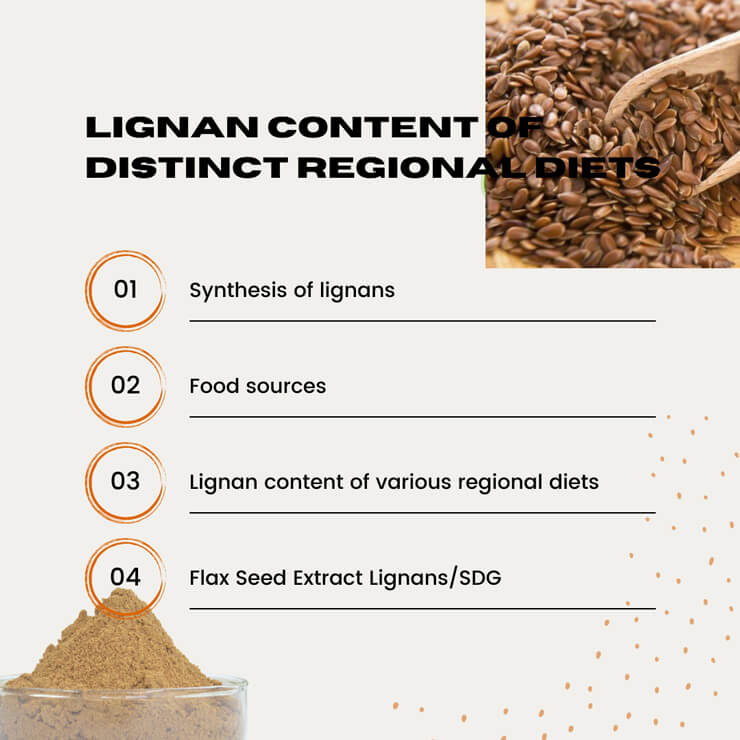Lignan is broadly distributed in plant origin. It is present in more than 55 plant families, where they function as defense molecules against harmful fungi and bacteria and antioxidants.
The physiological and epidemiological studies in humans have shown that lignans can exert a beneficial effect in preventing lifestyle-related diseases. The list may include cancer and diabetes type of complications. For example, distinct types of estrogen-related tumors can be lessened with the dietary input of these polyphenols. I.e. breast cancer in postmenopausal women.
These bioactive compounds exhibit numerous biological properties.
Apart from this, a few lignans have furthermore stimulated pharmacological interest.
- Tracheologin and Arctigenin, collected from tropical climbing plants; have been tested to form a drug, used to treat AIDS.
- Podophyllotoxin attained from the Berberidaceae family; has been used as a chemotherapeutic agent.
Synthesis of lignans
The formation of lignans includes the pathway, which starts from 3 of the 4 prevalent dietary hydroxycinnamic acids.
– Sinapic acid
– P-coumaric acid
– Ferulic acid
Therefore, they come from the shikimic acid pathway by phenylalanine.
Food sources
Flaxseed, often known as linseed is the richest source of lignans. Other significant sources are sesame seeds and whole grains. Secoisolariciresinol and Matairesinol were the first Flaxseed Extract specified in foods. Some other foods contain lignans/SDG but concentrations from 100-1000 times lower than that of flaxseed. Some of them are-
- Fruits including pears, apricots, peaches, and strawberries
- Beverages like red wine followed by soy milk, black tea, and coffee.
- Lentils and beans
- In vegetables, they are found in garlic, Brassicaceae, carrots, and asparagus,
Lignan content of various regional diets
The consumption of dietary Flaxseed Extract depends on the geographical location but of course, diets are moreover subject to ethnic and cultural group influences.
- Mediterranean diet
- A traditional Mediterranean diet is characterized by low meat products, low sweets, a moderate intake of poultry and fish, and fermented dairy products. Whereas, unprocessed cereals, legumes, fruits nuts, and vegetables are taken into higher proportion.
- The Health benefits of this diet consist of increased bioactive compounds and fiber and a low intake of saturated fats. Hence, a major dietary source of Flaxseed Extract is fruits, legumes, oilseeds, and vegetables.
- Northern hemisphere diet
- It will cover the diet of the Nordic and northern European regions. It constitutes of high intake of seaweed, fatty fish, lean meats, legumes, vegetables, and fruits. It restricts the amount of salt and sugar in the diet. So, major plant sources and seeds, consumed here contain a good amount of Flaxseed Extract.
- Indian diet
- A major portion of a typical Indian diet includes fish, oils, coffee, grapes, chocolates, tea, and numerous vegetables.
- The Indian Mulberry, due to its high lignan content is used in the treatment of high BP, diarrhea, cancer, and diabetes. Apart from all, sesame, which is a typical part of the Indian diet, is one of the best sources of lignans.
- Asian diet
- This diet is mainly composed of noodles, spices, vegetables, rice, seafood, and soy products. Several major lignan plant sources are found in Asia and are commonly used in the diet.
- China makes use of these plants for making medicines i.e. ArticumLappa. Flaxseed extracts have garnered interest in the pharmacological world, due to their amazing effects in anti-inflammatory and anti-tumor effects.
- Latin American diet
- The basics of this diet contain maize, peanuts, potatoes, and beans. Latin American diet also includes flax seeds in a good ratio. Flax seeds, along with legumes are the best source of Flaxseed Extract. Diets rich in flax diets ensure a reduced risk of osteoporosis, CVDs, and diabetes.
Conclusion
The Asian diet has grabbed the first position to have the highest intake of Flaxseed Extract in their diet. Which also concludes, a higher bioavailability. It is because of high vegetable consumption and the infusion of lignan-rich plants in medicines.
After the consumption of plant lignans, they go through the metabolism process by intestinal bacteria. They are then transferred into mammalian Flaxseed Extract before the process of absorption. This ultimately, reduces the risk of various types of cancer, specifically of the prostate, colon, and breast ones. Several studies confirm a positive correlation between plant Flaxseed Extract consumption and enterolignan levels. Enterolactone and enterodiol are the first lignans to be detected in human biological fluids, post-ingestion of lignans. 13-5 hours respectively are the half-lives of these compounds and they continue to be detectable even after 8 to 10 hours of their consumption.








